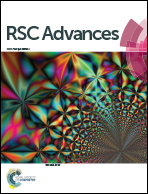Unsymmetrical squaraines with new linkage manner for high-performance solution-processed small-molecule organic photovoltaic cells†
Abstract
Squaraines are promising donor materials because of their strong and broad absorption band in the visible and near infrared regions which is suitable for application in organic photovoltaic (OPV) cells. Two unsymmetrical squaraines (USQs), namely BIBISQ and TIBISQ, with two electron-donating aryls directly linked to the electron-withdrawing squaric acid core (Y-manner) can act as high performance donor materials for solution-processed bulk-heterojunction (BHJ) OPV cells. Both USQs show ideal low bandgaps (1.47 eV for BIBISQ and 1.39 eV for TIBISQ) with an intense and broad absorption band in the range of 500–900 nm, and relatively low HOMO levels of ∼−5.10 eV. The BHJ-OPV device based on both of them simultaneously showed excellent short current density (Jsc) (over 13 mA cm−2), open circuit voltage (Voc) (0.84 V), fill factor (FF) (0.49) and power conversion efficiency (PCE) of over 5% under a blend ratio of USQs : PC71BM = 1 : 3. These results indicate that the two USQs are quite promising candidates for small molecular (SM) OPV cells and the Y-manner should be a quite successful linking method for USQs.


 Please wait while we load your content...
Please wait while we load your content...